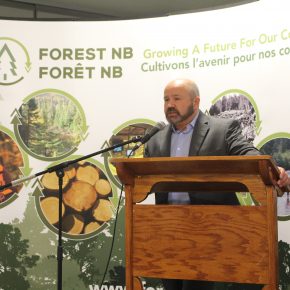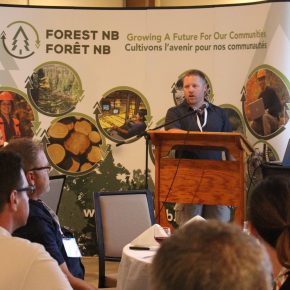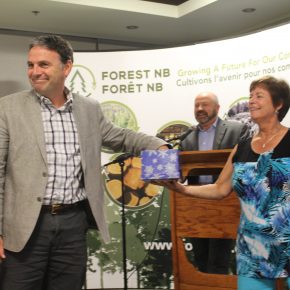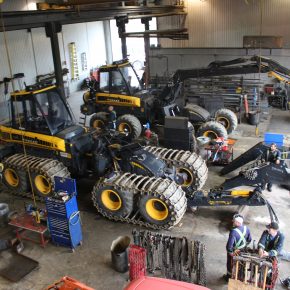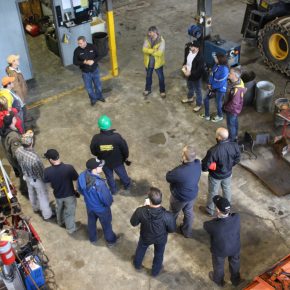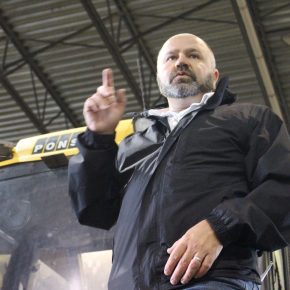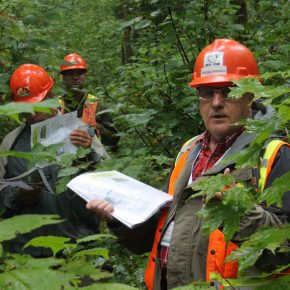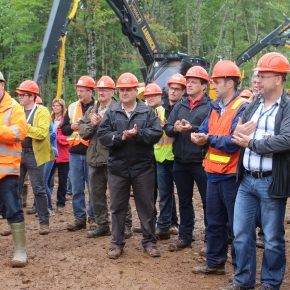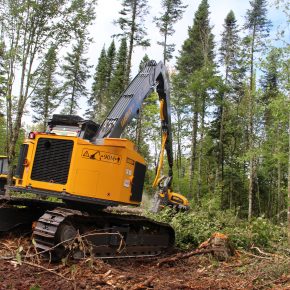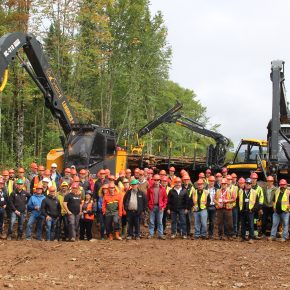Attendance doubles at 2016 Forest NB semi-annual meeting and field tour
- Forest NB Executive Director, Mike Legere, welcoming attendees at dinner.
- Dr. Rob Johns giving a presentation on Spruce Budworm.
- Drawing the name of the recipient of the Ernie Strickland Scholarship.
- A.L.P.A. Equipment’s facility in Balmoral
- Yann Savoie delivering a presentation at A.L.P.A. Equipment’s facility in Balmoral.
- Forest NB Executive Director, Mike Legere.
- Gaetan Pelletier from the Norther Hardwoods Research Institute explaining
- Group shot following a Landrich harvester demonstration on an A.V. Group active harvest demo block.
- A Landrich harvester in action on an active harvest demo block near Campbellton.
- A shot fo the whole group during this year’s field tour.
Nearly 80 forest industry professionals and stakeholders dawned their hard hats and took to the woods as part of Forest NB’s Semi-Annual Meeting and Field Tour from September eighth to ninth in Campbellton.
The event provides an opportunity for members of the association to discuss the current state of affairs in the industry and issues facing the sector. A recently added field tour component allows participants to experience forestry operations first-hand in the woods.
“I think it was very successful,” said Forest NB Executive Director, Mike Legere. “We had a good showing from non-industry participants from the municipalities and the business community.”
The two-day event began with an industry luncheon, followed by a tour of Chaleur Sawmills’ facility in Belledune. The mill produces approximately 170 million board feet of lumber annually – enough to construct roughly 12,500 homes every year.
From there, the group took a pit stop at popular local enterprise, Shiretown Beer in Charlo, for a pint and tour of their craft brewery.
“It’s a great example of local entrepreneurship within a forest sector dominant region,” said Legere.
Dr. Rob Johns from the Canadian Forest Service delivered a presentation after Thursday’s dinner, discussing recent spruce budworm activity in northern New Brunswick. The lecture highlighted the insect’s history in the province, and presented contemporary research projects being implemented to learn more about managing future outbreaks. Johns’ team is engaging with communities by asking citizens to place budworm traps in trees to assist current research.
At breakfast the next morning, Dr. Doug Pitt from the Canadian Forest Service delivered a presentation on the role of vegetation management in forest renewal. Pitt’s lecture provided information on various types of vegetation management, including manual thinning, pre-commercial thinning and glyphosate application. He explained why vegetation management is an important aspect of renewing a healthy forest, and that different areas of forest require different management methods.
A.L.P.A. Manufacturing sells and produces heavy equipment for New Brunswick’s forest industry. The group visited their facility in Balmoral to learn more about the company and the products they distribute.
The final leg of the event involved a tour of AV Group’s local forestry operations in the Campbellton area, where participants got to see A.L.P.A.’s equipment in action. A.L.P.A.’s master harvester operator demonstrated the versatility and efficiency of the Ponsse brand equipment on an active harvest demo block. From there, the group visited a hardwood stand where Gaetan Pelletier from the Northern Hardwoods Research Institute explained the process of an overstory removal. The tour wrapped up with visits to an active pre-commercial thinning block and a clearcut that received glyphosate treatment and has been replanted.
“I thought it was incredibly well organized,” said Paul Watson, engineering technologist at the City of Campbellton. “As someone who’s not directly involved in forestry, it was incredible education for me. I didn’t realize there was still that much going on in the area.”
Watson was pleasantly surprised by the group’s visit to Chaleur Sawmills, as the facility differed greatly from his preconceptions of a typical mill.
“You see the technology involved and see that nothing from the tree is going to waste. It’s sustainable and environmentally friendly.”
Learning about the careful planning involved in all aspects of forestry was a highlight for Watson.
“I had always had this impression that clear cuts were a wasteland. I didn’t realize that it was so well managed and that there are different experiments going on to manage the regrowth and sustainability,” he said.
Legere says that presenting this information to individuals who do not work in the forest industry is an important and valuable aspect of the field tour.
“It’s challenging because you have a mix of industry people who have an intimate knowledge of the forestry sector, and then you have people who are quite removed from the sector in that they don’t work in it day-to-day,” he said. “But AV and A.L.P.A. were really good at striking a balance between not watering down too much for the industry people, yet not making it so technical that the average person couldn’t understand.”
Presentations on topical issues within the sector are also valuable components to the event Legere says, as they provide factual information that help individuals understand forestry practices.
“Our use of herbicide as a management tool is important to industry, but because it’s a herbicide people have concerns, and legitimately so,” he said. “It’s important that we can bring in experts to inform their opinion on the use of herbicide, otherwise the public is only hearing what’s put out by critics or people opposed to it.”
As an association that represents New Brunswick’s forestry sector, Legere recognizes the importance of holding the event at various locations throughout the province. After a successful event last year in Miramichi, Legere was hoping to see an increase in attendance this year. The number of participants doubled – something Legere attributes to a renewed interest in the forest sector.
Watson thinks field tours like this play an integral role in educating non-industry professionals on modern forestry practices.
“I think it’s important because it’s an industry in the province that unless you’re in it, you don’t see it. If you live in the city you’re not going to be on the back roads seeing it,” he said. “With the engagement you guys are doing, it really opens up your eyes.”

